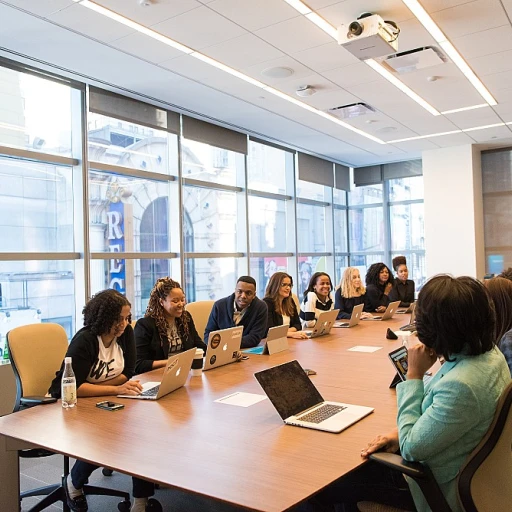Understanding the Role of Coaching and Mentoring
The Importance and Distinction of Coaching and Mentoring
Understanding the role of coaching and mentoring is fundamental for those striving to build a supportive and effective learning network. Both concepts share the core idea of guiding individuals toward personal and professional growth, but they differ significantly in approach and focus.
Coaching is a structured dialogue process designed to support a client's specific developmental goals, often focused on performance and skills enhancement. Whether you are a professional, part of a small community in Ohio, or a leader of a global team, the presence of a knowledgeable coach can lead to significant improvements in talent management. Coaching supervision plays a crucial role in ensuring that coaches maintain high standards, providing them support and continuous development.
Mentoring, on the other hand, tends to take a broader, more informal approach, offering guidance centered around holistic personal growth and career path exploration. A mentor acts as a role model, sharing invaluable insights gained from years of experience, which can be especially beneficial to members of professional groups, such as Ohio coaching association or even organizations like network ocam (an Ohio prevention education body). The mentor-mentee relationship focuses less on immediate task completion and more on overall development and long-term success.
Moreover, with the advance of virtual platforms and social networks like LinkedIn, the ability to strengthen your mentoring network has never been more accessible. These platforms not only widen the scope of potential mentors and coaches you can connect with but also integrate various forms of training and supervision that can enhance the quality of professional relationships.
Actualizing the potential of coaching and mentoring involves a clear understanding of their respective roles. Whether through structured coaching sessions with experienced certified professionals or engaging in conversations that draw from a diverse well of professional knowledge, these practices empower prevention professionals and enhance workforce development.
For those involved in creating personalized training plans or contributing to organizational excellence in talent management, distinguishing the nuances between these roles is key. To further enrich your understanding of these practices, you may want to read more about the comprehensive approaches to individualized planning in "
Understanding an IEP Plan: A Comprehensive Guide."
Benefits of a Coaching and Mentoring Network
The Positive Outcomes of a Supportive Mentoring Network
A well-established coaching and mentoring network delivers numerous advantages. By understanding these benefits, you can appreciate their impact on continuous learning and professional development.
- Enhanced Skill Development: Engaging with experienced professionals such as coaches and mentors allows individuals to refine their skills. This improvement stems from regular feedback and guidance, which are crucial in preventing stagnation and encouraging progress.
- Expanded Professional Network: Making connections with diverse coaches and mentors fosters a sense of community and opens doors to new opportunities. It is essential for talent management and professional growth.
- Boosted Confidence and Motivation: Having support from a dedicated coach or mentor helps build confidence. This motivational boost is vital for achieving personal and professional goals.
- Increased Job Satisfaction: Continuous coaching and mentorship often lead to higher job satisfaction. By addressing areas of concern and enhancing skill sets, individuals feel more competent and fulfilled in their roles.
- Improved Career Development: With guidance from coaches, mentors, and partner organizations, professionals can navigate their career paths more effectively. This involves skills training and maximizing potential by integrating what they’ve learned.
Moreover, institutions like OCAM and Ohio Coaching support workforce development by providing essential supervision and training opportunities. Establishing a robust mentoring network within such frameworks accelerates individual growth.
Unlock opportunities for career advancement with initiatives like student-night scholarships, which foster continuous learning and development. Consider exploring scholarships and training programs to further benefit from your mentoring network.
Incorporating these elements will undoubtedly make your journey towards professional excellence more rewarding and effective.
Building Your Coaching and Mentoring Network
Establishing a Diverse and Supportive Environment
Building a robust coaching and mentoring network necessitates a keen emphasis on creating a supportive ecosystem that fosters growth. In order to craft this environment, it is imperative to collaborate with experienced certified professionals across various domains. Drawing upon the knowledge of these experts, such as those specializing in coaching, mentoring, prevention education, and talent management, enables participants to receive a holistic development experience.
A diverse mentoring network should also include certified Ohio professionals, particularly in fields like Ohio coaching and prevention. This integration not only provides a regional perspective but also helps in aligning local workforce development efforts with broader global objectives.
Leveraging Organizational Structures and Resources
Partnering with organisations such as the Ohio Coaching and Mentoring (OCAM) community is vital. These bodies offer not only structural support but also provide strategic alignment with their existing coaching supervision and social network infrastructure. Coaches, mentors, and prevention professionals within the community can share insights and resources vital for professional growth and long-term success.
The value of tapping into an established network often lies in how an individual can utilize various platforms to expand their connections. Social media, especially LinkedIn, serves as a crucial tool for linking with global coaches and mentors. By actively participating, professionals can enhance their ‘mentoring network’ and benefit from shared expertise.
Integrating Technology for Seamless Communication
In today's fast-paced environment, embracing technology is no longer optional but essential for maintaining an effective coaching network. While face-to-face interactions remain invaluable, virtual communication tools facilitate continuous engagement irrespective of geographical barriers.
By using email and virtual supervision tools, for instance, Ohio prevention and coaching professionals can efficiently manage their schedules and collaborate with their peers. It also allows for regular progress checks and ensures that the mentoring process remains aligned with the overall objectives. For those looking to capitalize on available technologies, exploring options like online skills training and support development platforms can provide significant advantages.
For more insights on how to strategically employ network solutions to enhance your learning journey, explore
strategic network solutions. By understanding the dynamic nature of these interactions, participants can maximize their growth potential through a well-curated mentoring network.
Leveraging Technology in Coaching and Mentoring
Leveraging Digital Tools for Enhanced Guidance
In the evolving landscape of coaching and mentoring, the integration of technology has emerged as a pivotal element. The use of digital tools not only strengthens the existing connections but also extends reach beyond geographical boundaries, bridging gaps that years ago seemed insurmountable.
One of the most effective ways to promote coaching supervision and mentoring network is through social platforms like LinkedIn. LinkedIn offers a community where prevention professionals, coaches, and mentors can connect. These connections facilitate the sharing of insights and provide a platform where experienced certified individuals offer valuable guidance to those in the early stages of their professional journeys.
Virtual Communities and Learning Platforms
Establishing a virtual community is another significant step in enhancing your coaching and mentoring efforts. Platforms designed for workforce development such as OCAM (Ohio Coaching and Mentoring) provide access to ohio coaching resources and training modules tailored towards skills training. These virtual hubs are essential for prevention education and coaching supervision, ensuring that talent management objectives are met effectively.
Furthermore, email communication remains a vital tool for ongoing dialogue between mentors, coaches, and mentees. It ensures that all participants in the coaching network, whether they are part of a local team in Ohio or engaged in global exchanges, can maintain consistent contact and share valuable resources on a regular basis.
Integration with Organizational Goals
Successfully leveraging technology in coaching and mentoring demands aligning digital strategies with organizational goals. Partner organizations must emphasize the view that technology is a means to support development initiatives and not just an add-on. This perspective is critical for ensuring that coaching and mentoring programs are not only functional but impactful across various levels of the org.
For prevention professionals and teams seeking to maximize the use of technology in their coaching mentoring initiatives, it's crucial to incorporate regular training sessions. These sessions can guide both coaches and mentors in effectively utilizing the digital tools at their disposal, ensuring that the network is used to its full potential.
Overcoming Challenges in Coaching and Mentoring Relationships
Confronting Challenges in Coaching and Mentoring Connections
In the dynamic world of coaching and mentoring, professionals often encounter several obstacles that can impede the effectiveness of these relationships. Identifying and effectively addressing these hurdles is crucial for fostering a meaningful and productive mentoring network.
Firstly, understanding the diversity within your coaching and mentoring interactions is vital. Partner organisations and community members from different cultural and professional backgrounds each bring unique perspectives and challenges. For example, coaches in Ohio might have different approaches compared to global counterparts. Recognizing these differences helps in preventing misunderstandings and promotes smoother communication.
A major hurdle is ensuring open and continuous communication between the coach and the mentee. Utilizing digital tools such as email, LinkedIn, and virtual platforms can enhance interaction and maintain consistent support, particularly in a geographically diverse network. However, while technology offers a conduit for connection, it also presents challenges around maintaining personal touch and genuine engagement.
The role of supervision in coaching and mentoring networks cannot be underestimated. Coaching supervision can provide essential feedback and guidance, enabling coaches to enhance their skills and adaptability. Regular supervision sessions can equip coaches and mentors with the tools to overcome barriers in coaching programs and support development.
Trainers and prevention professionals seeking to implement coaching strategies must also invest in relevant skills training for the team involved. Professional growth is a continuous journey, and both seasoned coaches and beginners benefit from such training to keep up-to-date with best practices.
Additionally, overcoming resistance within a team or from individuals can pose a significant barrier. The solution lies in demonstrating the tangible benefits of these relationships, as highlighted in professional development and talent management strategies. A well-structured mentoring network can significantly contribute to workforce development, reducing the resistance often encountered years ago.
In essence, overcoming these challenges requires a collaborative approach, leaning on the network’s collective strengths. By preparing for and addressing these issues proactively, the pathway to cultivating a robust, supportive coaching and mentoring environment becomes more attainable.
Measuring the Impact of Your Coaching and Mentoring Network
Evaluating the Effectiveness of Your Mentoring and Coaching Strategies
When striving to foster continuous learning through coaching and mentoring networks, measuring the impact of your initiatives is crucial. Not only does this help gauge the success of your strategies, but it also aids in making informed adjustments to better meet the needs of your community or organization.
Firstly, it’s essential to establish clear objectives and metrics tailored to your coaching and mentoring goals. These metrics might include:
- The rate of skill acquisition among participants.
- Enhanced job satisfaction and engagement levels measured through surveys.
- The development of leadership skills observable in real-world scenarios.
Implement tools such as feedback forms and regular check-ins via email or team meetings to capture qualitative and quantitative data about the coaching and mentoring experience. This real-time feedback loop allows coaches to adapt their methods, ensuring they align with participants' expectations and learning styles.
Moreover, leveraging technology can significantly fortify your evaluation process. Workforce development software and platforms such as LinkedIn or network-specific tools can facilitate tracking progress and networking outcomes. These digital arenas also provide valuable analytics that can gauge the effectiveness of various training modules and skills training sessions offered.
Incorporating coaching supervision enhances the impact assessment by providing a layer of quality control. Experienced certified professionals can offer insights into best practices and areas requiring improvement. Engaging with partner organisations or global mentors can expand your view, providing a broader perspective on effective techniques and methodologies in the field.
Preventive measures are equally vital in evaluating impact. Ensure your network establishes a solid framework to handle potential challenges, as these obstacles could affect the overall effectiveness of your coaching and mentoring initiatives. Prevention professionals can offer strategies to preemptively address concerns, such as cultural differences within a diverse virtual network or resistance to change among participants.
Ultimately, the success of your coaching and mentoring network hinges not only on the quality of mentors and coaches but on the precise analysis of developmental outcomes. Embedding a consistent assessment mechanism into the fabric of your network allows for continued growth and adaptation, ensuring a robust and impactful experience for all involved.













